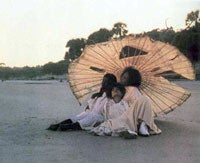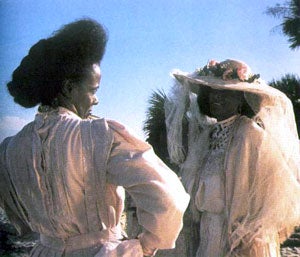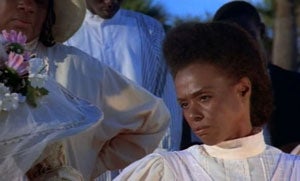On October 7, 2011, we premiered the first fully timed second answer print of Daughters of the Dust. Below is an abridged version of my opening remarks:
Tonight we are opening a three month series, “L.A. Rebellion: Creating a New Black Cinema,” which as far as I can tell is the biggest thing the Archive has ever planned and executed, involving literally every member of the staff at some point in the last three years, from Trisha Lendo in shipping and inspection to Amanda Mack in cataloging to Marla Watson in our archivists’ office to Tony Best in our digital suite to Tim Wilson at the Stanford Theatre Lab to Nina Rao in programming to Mbarak Namoya in our business office. My time allotment prevents me from thanking all 55 members of the Archive staff. But, I can’t tell you how proud I am of them all for pulling off this monumental accomplishment.

The project began for a call for proposals from the Getty Foundation, which was planning a massive exhibition on post war L.A. Art, Pacific Standard Time. PST has of course come to fruition, as witnessed by the most exciting event in L.A. art history, including the Hammer’s exhibit on African American Art, “Now Dig This,” on view right in this building. Our proposal to stage a film program about a group of somewhat known, but little understood, African and African American filmmakers who studied at UCLA in the 1970s and early 1980s was accepted and we were off.
Once we began the initial research, conducting oral histories with the participants, we realized that this program would not just be a matter of pulling together a few films that were in distribution. Furthermore, our initial group included only about eight to ten names and we soon learned there were many more. Now we know of over 50 student filmmakers, and this program represents the work of 21 of them, and over 50 films. So we had to identify the filmmakers, find their films—often left in forgotten closets, storage bins or at laboratories, intake and catalog the films into our collections, restore the films or make new copies, create a program, catalog and website. And the work of preservation continues, as does planning for an international and national tour.

It is our belief that the L.A. Rebellion constitutes a movement of major import to the history of American cinema. For the first time, whether inside or outside the Hollywood system, a group of filmmakers of color produced a coherent body of work that holds up under close scrutiny both in terms of its ideological thrust, its social concerns, and its aesthetics. Significant also—and I can’t emphasize this enough given the glowing but male-oriented reviews we have thus far received—is that this a movement with gender parity. For every Charles Burnett, Haile Gerima, Larry Clark and Jamaa Fanaka, there is a Julie Dash, a Barbara McCullough, an Alile Sharon Larkin, a Carroll Parrot Blue, an Ijeoma Iloputaife, a Zeinabu irene Davis, and many more. For the curators, Professor Jacqueline Stewart from Northwestern, Professor Allyson Nadia Field from UCLA, our Head of Programming, Shannon Kelley, and myself, this has been an extraordinary adventure and we invite you now on the journey.
Tonight’s two films are brand new, never before screened prints. Four Women (1975) was generated by the Stanford Theatre Lab and my thanks go to senior preservation Ross Lipman and lab manager Sean Hewitt among others for their work. Daughters of the Dust is a world premiere of sorts, in that it is the first fully-timed print ever generated and the first new print to be struck in 12 years and since Julie’s film was named a national treasure by the National Film Preservation Board in 2004. Moving beyond the initial timing of the first answer print to a corrected, timed print was crucial to bringing out the incredibly delicate and subtle palette of Arthur Jafe’s cinematography. My thanks go to Janice Allen and Cinema Arts, Inc. for once again allowing access to the negatives of this seminal film.

Finally, I want to add a very personal note. I think the curatorial team would agree that this project has been and continues to be incredibly exciting and educational, but also deeply humbling. In reconstructing the chronology and history of the movement, we have witnessed the incredible accomplishments of a whole generation of filmmakers specifically schooled at UCLA. Regrettably, we have also seen many of their hopes and aspirations dashed on the rocks of American culture, and much more importantly capital, which has historically undervalued and continues up until the present day to undervalue the contributions of most people of color in all walks of life. I’m proud that this public university has now attempted to rectify that situation, at least in regards to the L.A. Rebellion filmmakers.
Nevertheless, I’m intensely aware of the fact that were our society equal in all respects, the recuperation of African American culture would be handled by institutions like the Pan-African Film Festival and the Mayme Clayton Library, which, because we are not yet that society, has been forced to place its collections of historical Black film on deposit at UCLA Film & Television Archive. So it is with these conflicted feelings, both joy and a keen sense of melancholy, that I believe is also at the core of Julie’s film, that I thank you and hope you enjoy Four Women and Daughters of the Dust.






 Mobile Navigation
Mobile Navigation

